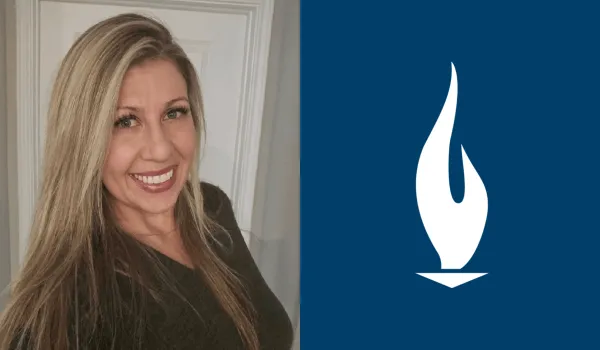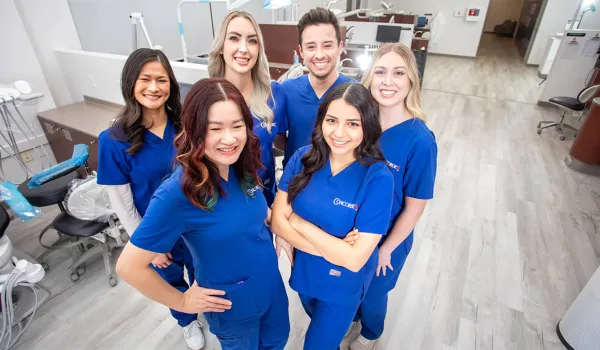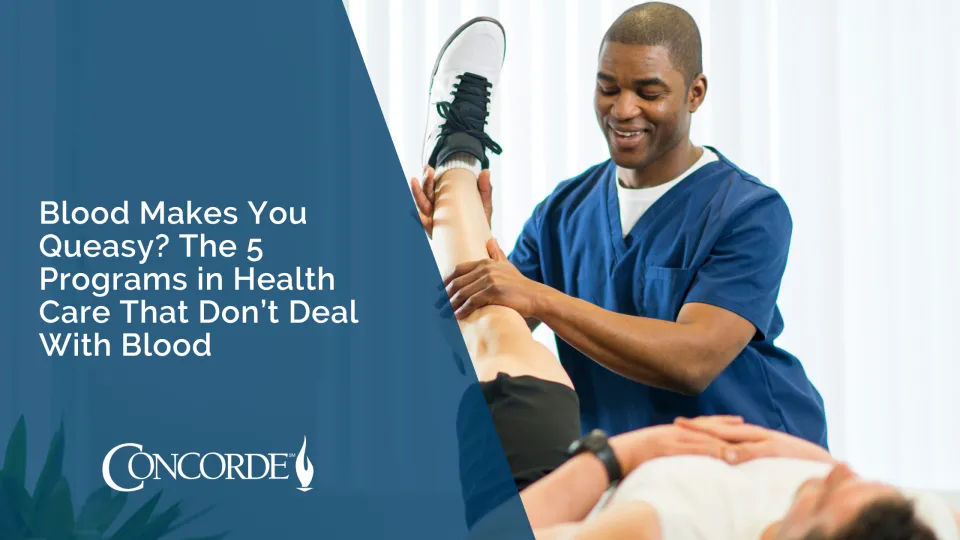
Does the sight of blood make you feel ill? If so, you're not alone. According to some researchers, up to 4% of the general population suffer from hemophobia (1), an extreme aversion to the life-sustaining fluid that flows within us all. In extreme cases, seeing blood can lead to vasovagal syncope (2), in which a person's heart rate and blood pressure drop precipitously, causing a fainting spell.
One might think that hemophobia would prevent someone from entering the medical field, but that's not necessarily the case. There are numerous health care positions that don't deal with blood at all, and others that encounter it on only a limited basis. Let's take a look at some programs that the blood-squeamish among us might consider pursuing.
| Program | Description |
|---|---|
| Respiratory Therapy | Focuses on aiding patients with breathing difficulties across various conditions. |
| Physical Therapist Assistant | Assists in rehabilitating patients with physical function impairments. |
| Massage Therapy | Entails therapeutic manipulation of body tissues. |
| Cardiovascular Sonography | Utilizes ultrasound for heart condition diagnoses. |
| Pharmacy Technician | Supports pharmacists in medication preparation and dispensing. |
| Medical Office Administration | Manages healthcare office operations, including billing and coding. |
Respiratory Therapy
Respiratory therapy is a health care specialization that centers on helping patients with breathing difficulties. Practitioners within this field, called respiratory therapists (RTs), work with patients of all ages who suffer from respiratory conditions such as asthma, chronic obstructive pulmonary disease, and pneumonia. They may also treat individuals who've undergone lung surgery, as well as those with non-respiratory diseases that affect breathing (e.g., congestive heart failure).
There are several types of respiratory therapy careers in which a practitioner may specialize, such as:
- Long-term care: Those who specialize in long-term care treat patients with chronic respiratory disorders, who are typically middle-aged or older. Such patients commonly reside in long-term care facilities such as nursing homes.
- Critical care: Specialists in critical care respiratory therapy typically manage patients postoperatively or perioperatively. Their patients are often visitors to the emergency room or those recovering from heart surgery or lung failure.
- Neonatal/pediatric respiratory therapy: Neonatal and pediatric RTs work with children, including premature newborns. They can be essential for ensuring the survival of babies shortly after birth, as well as for treating congenital diseases like cystic fibrosis.
- Pulmonary rehabilitation: Specialists in pulmonary rehabilitation also help patients with chronic respiratory diseases, helping them to adapt to their condition and optimize their quality of life.
RTs commonly work as part of a multidisciplinary team that includes physicians, physician assistants, registered nurses, and other medical practitioners. Their duties include examining patients, conducting diagnostic tests of respiratory function, educating patients about their conditions, and providing guidance on medications and respiratory aids. Bear in mind that some respiratory therapists may draw blood to determine its gas contents, but this is only a small and infrequent task associated with the profession.
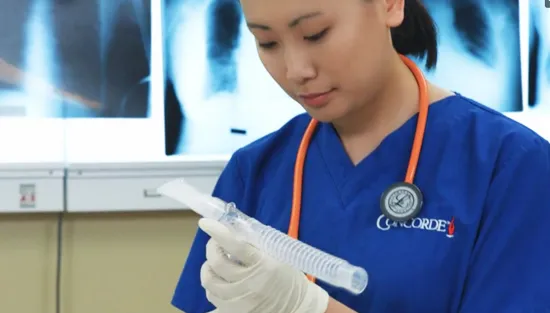
An associate degree is the minimum education requirement to become an RT. Licensure is a requirement in almost all states, though licensing requirements may vary. Only Alaska doesn't require licensure, though it does recommend national certification. The primary certifying body in this field is the National Board for Respiratory Care (3).
Physical Therapist Assistant
A physical therapist assistant (PTA) is a patient care professional who plays a support role in a physical therapy regimen. Working under the direct supervision of a physical therapist, they assist in the recovery of patients with injuries or illnesses that have compromised their physical function. The goal with every patient is to help them regain the ability to move normally while managing any associated pain.
PTAs usually work in either hospitals or private practices, particularly those dedicated to physical therapy. However, it's not uncommon to find PTAs in other work environments, including rehabilitation centers and schools. Some work in the home health subsector, helping to provide treatment in patients' homes.
A PTA may perform a wide range of duties in their role. The observation of patients is a critical ongoing responsibility that involves monitoring therapeutic progress and reporting changes to the physical therapist. To facilitate healing, the assistant may help the patient perform exercises, apply massage or stretching techniques, instruct the patient on the use of ambulatory aids, and counsel them on post-treatment protocols.
Additional duties may arise as needed. Common ancillary responsibilities of the role include, but aren't limited to:
- Cleaning treatment areas
- Washing sheets and linens
- Transporting patients
- Scheduling appointments and follow-ups
- Answering phones and completing correspondence
Interested in how to become a physical therapy assistant? You will need to have at least an associate degree from an accredited program. Over the course of your studies, you'll cover courses in anatomy, kinesiology, and physiology in addition to topics such as therapeutic exercises, ambulation and mobility training, functional training, and activities of daily living. After earning your degree, you also need licensure or certification to practice as a PTA.
Massage Therapy
Massage therapy is the practice of manipulating the soft tissues of the body to achieve therapeutic benefits. Patients seek massage therapy to relieve pain, reduce muscle tension, alleviate stress, and even enhance their immune function. It's a common component of integrated medicine (4), which refers to the incorporation of alternative medical techniques with orthodox treatments.
The primary duty of a massage therapist (MT) is to apply touch and pressure to areas of a client's body to achieve specific therapeutic goals. The physical practice of massage involves pressing, rubbing, and kneading with the fingers, hands, elbows, or feet. Oils and lotions allow the MT's appendages to glide across a client's body more easily and effectively.

In service of their primary duty, an MT will discuss medical histories, symptoms, and desired outcomes with their clients. Like a physician, they also examine clients by identifying points of pain or tension, and they educate clients on stretches or exercises to perform at home. They may also maintain records of a client's condition to monitor their progress from session to session. In a postsecondary massage therapy program, aspiring MTs study the human body and acquire the physical skills of massage. Coursework typically covers anatomy, physiology, kinesiology, pathology, and ethics. Licensure or certification is a requirement to practice massage therapy in most states. The licensure examination may be state-specific, or it may be the exam offered by the Federation of Massage Therapy Boards (5).
Cardiovascular Sonography
Cardiovascular sonography is a specialization in the field of diagnostic medical sonography, which is itself a branch of medical imaging that uses ultrasound to determine the etiologies of medical conditions. Cardiovascular sonographers use specialized equipment to send sound waves into the body to create dynamic images of the heart and its structures. This type of imaging can reveal important information about a patient's most important vital organ, such as abnormalities and the etiologies of serious heart conditions.
As with other sonography types, cardiovascular sonographers perform a variety of duties in the execution of their role. When working with new patients, they begin by taking medical histories before explaining the particulars of the diagnostic procedure the patient will undergo. During the procedure, the sonographer operates the ultrasound equipment to obtain the best imaging possible. Afterward, they examine and interpret the images, record their interpretation, and report their findings to relevant parties. Outside of these duties, sonographers may also maintain the diagnostic equipment they use, to ensure proper functioning.
Cardiac sonographers also perform tasks that are specific to their specialization. They analyze ultrasound imaging to identify heart-related complications, such as abnormal heart valves and the potential causes of chest pain. Additionally, they track patients' heart conditions and monitor them for changes. They may perform these duties in a variety of settings, including emergency departments and intensive care units.
An associate degree in sonography is the minimum education requirement to become a cardiac sonographer. Professional certification can maximize one's chances of securing a position. Cardiac Credentialing International (6) offers multiple certifications for this profession in particular. Other certifying bodies include the American Registry for Diagnostic Medical Sonography (7) and the American Registry of Radiologic Technologists (8).
Pharmacy Technician
A pharmacy technician (PT) is a health care professional who supports pharmacists in retail pharmacy or hospital settings. What does a pharmacy technician do? Their role is important for ensuring that patients and health professionals receive the right types and dosages of medications.
The primary responsibility of the job is to locate, package, label, and dispense prescription drugs. To carry out this responsibility, a PT also performs a diverse range of ancillary duties. They process health information from medical practitioners so that patients receive the correct prescriptions, handle pharmaceutical inventories so that sufficient resources are available to dispense medications, complete transactions with patients, and update patient entries in relevant databases. PTs may perform administrative tasks as well, such as filing paperwork, taking phone calls, answering questions, making material orders, and processing insurance claims. Other duties may include:
- Operating automated equipment, particularly for dispensing prescriptions
- Compounding prescriptions
- Scheduling vaccinations and pharmacist consultations

One can become a pharmacy technician with a high school diploma, but a postsecondary education improves their candidacy for the position. Associate-level programs in pharmacy technology usually cover a broad array of topics, including record-keeping, pharmacy law, and arithmetic. PTs must also learn the names and uses of particular prescription drugs, along with their common dosages.
Aside from education, the formal requirements to become a Pharmacy Technician vary from state to state, though they commonly include a combination of examinations, fees, criminal background checks, and continuing education. Certifications are available and can improve an individual's candidacy for a PT position. The Pharmacy Technician Certification Board (9) offers multiple levels of certification. Another option for certification is through the National Healthcareer Association (10).
Medical Office Administration
Medical office administration (MOA) refers to the myriad activities that go into managing the operations of a health care or health care–related establishment. It's a broad field that encompasses a large number of professions, including:
- Admissions clerks
- Billing clerks
- Hospital unit managers
- Medical assistants
- Medical coders
- Medical transcriptionists
- Records managers
Medical office administrators work in a variety of professional settings, including hospitals, long-term care facilities, clinics, private practices, and even insurance companies. The most visible component of their work involves front-office duties, such as greeting patients, directing patient check-ins, answering phones, and writing correspondence. They may also perform additional duties that relate to:
- Patient histories: To facilitate care delivery, medical office administrators may take patients' histories before their appointments. They then input the information into patient databases for ready access by medical practitioners.
- Communication: It's often the responsibility of MOA professionals to convey information to relevant parties, such as medical histories and lab results to patients or physicians.
- Medical coding: The practice of medical coding refers to the translation of diagnoses and procedures to alphanumeric codes.
- Insurance: Medical office administrators handle the filing and billing of insurance claims so that patients' policies can cover part or all of the costs of their care.
- Transcription: Medical transcription is the practice of writing down the details of patient encounters with physicians. These transcribed documents are useful for the maintenance of patient records and the processing of insurance claims.
- Scheduling: Administrators not only book patients for examinations and procedures but also coordinate physicians' timetables to optimize appointment times.
- Inventory: Administrators also monitor stocks of supplies and equipment and submit orders as needed.
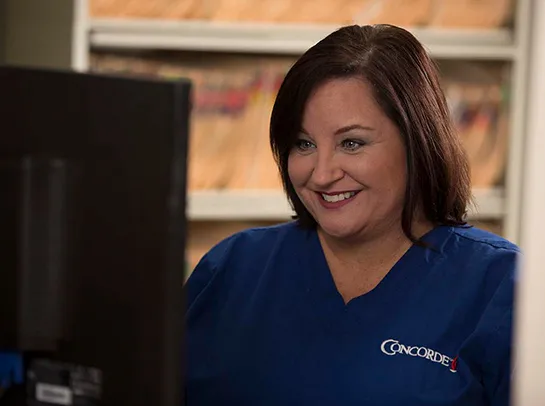
To succeed in the execution of their role, medical office administrators require a mix of hard and soft skills, particularly in areas such as data entry, typing, software literacy, customer service, organization, verbal and written communication, and multitasking. A diploma or associate degree program in MOA can equip aspiring administrators with these and other competencies.
It's perfectly okay to be uncomfortable around blood, and it doesn't have to get in the way of a rewarding career as a health care professional. If you're interested in starting down a path toward any of the professions mentioned here, get in touch with a nearby Concorde campus to discover what opportunities are available to you.
Footnotes
(1) "Blood Injury and Injection Phobia: The Neglected One," National Library of Medicine, https://www.ncbi.nlm.nih.gov/pmc/articles/PMC4094700/
(2) "Vasovagal Syncope," Mayo Clinic, https://www.mayoclinic.org/diseases-conditions/vasovagal-syncope/symptoms-causes/syc-20350527
(3) National Board for Respiratory Care Home Page, National Board for Respiratory Care, https://www.nbrc.org/
(4) "Integrated Medicine," National Library of Medicine, https://www.ncbi.nlm.nih.gov/pmc/articles/PMC1119398/
Take The Next Step Towards a Brighter Future
We have a Concorde representative ready to talk about what matters most to you. Get answers about start dates, curriculum, financial aid, scholarships and more!



